Limitations of Boulder Detection in Shallow Water Habitats Using High-Resolution Sidescan Sonar Images
Abstract
:1. Introduction
- (a)
- What SSS image resolution is required to quantify stones and boulders in shallow water areas?
- (b)
- How do range settings influence the detection quality of individual stones and boulders in high-resolution SSS images?
Regional Setting
2. Methods
3. Results
3.1. Study Area
3.2. Effect of Resolution
3.3. Effect of the Range
4. Discussion
5. Conclusions
Author Contributions
Funding
Acknowledgments
Conflicts of Interest
References
- Le Hir, M.; Hily, C. Macrofaunal diversity and habitat structure in intertidal boulder fields. Biodivers. Conserv. 2005, 14, 233–250. [Google Scholar] [CrossRef]
- Boedeker, D.; Krause, J.C.; von Nordheim, H. Interpretation, identification and ecological assessment of the NATURA 2000 habitats “sandbank” and “reef.”. In Progress in Marine Conservation in Europe; Springer: Berlin, Germany, 2006; pp. 47–64. [Google Scholar]
- Liversage, K.; Kotta, J. Disturbance-related patterns in unstable rocky benthic habitats of the north-eastern Baltic coast. Proc. Est. Acad. Sci. 2015, 64, 53–61. [Google Scholar] [CrossRef]
- Bundesministerium für Umwelt: Naturschutz Zustand der deutschen Ostseegewässer 2018. Umsetzung der Meeresstrategie-Rahmenrichtlinie 2018; Bundesminist. für Umw., Nat. und nukl; (BMU): Bonn, Germany, 2018; p. 191.
- Brown, E.J.; Vasconcelos, R.P.; Wennhage, H.; Bergström, U.; Støttrup, J.G.; van de Wolfshaar, K.; Millisenda, G.; Colloca, F.; Le Pape, O. Conflicts in the coastal zone: human impacts on commercially important fish species utilizing coastal habitat. ICES J. Mar. Sci. 2018, 75, 1203–1213. [Google Scholar] [CrossRef] [Green Version]
- Bertocci, I.; Dell’Anno, A.; Musco, L.; Gambi, C.; Saggiomo, V.; Cannavacciuolo, M.; Martire, M.L.; Passarelli, A.; Zazo, G.; Danovaro, R. Multiple human pressures in coastal habitats: variation of meiofaunal assemblages associated with sewage discharge in a post-industrial area. Sci. Total Environ. 2019, 655, 1218–1231. [Google Scholar] [CrossRef] [PubMed]
- Menza, C.; Kendall, M.S. Ecological Assessment of Wisconsin—Lake Michigan; NOS NCCOS 257; NOAA NOS National Centers for Coastal Ocean Science, Marine Spatial Ecology Division: Silver Spring, MD, USA, 2019; p. 106.
- Kolp, O. Die Sedimente der westlichen und südlichen Ostsee und ihre Darstellung. Beitr. Zur Meereskd. 1966, 17–18, 9–60. [Google Scholar]
- Winter, C. Monitoring concepts for an evaluation of marine environmental states in the German Bight. Geo-Mar. Lett. 2017, 37, 75–78. [Google Scholar] [CrossRef] [Green Version]
- Council Directive 92/43/EEC of 21 May 1992 on the Conservation of Natural Habitats and of Wild Fauna and Flora. 1992, p. 44. Available online: https://eur-lex.europa.eu/eli/dir/1992/43/oj (accessed on 20 August 2019).
- Bock, G.; Thiermann, F.; Rumohr, H.; Karez, R. Ausmaß der Steinfischerei an der schleswig-holsteinischen Ostseeküste. Jahresber. Landesamt Für Nat. Umw. Landes Schlesw.-Holst. 2003, 2003, 111–116. [Google Scholar]
- Karez, R.; Schories, D. Die Steinfischerei und ihre Bedeutung für die Wiederansiedlung von Fucus vesiculosus in der Tiefe. Rostock. Meeresbiol. Beitr. 2005, 14, 95–107. [Google Scholar]
- Schwarzer, K.; Bohling, B.; Heinrich, C. Submarine hard-bottom substrates in the western Baltic Sea – human impact versus natural development. J. Coast. Res. 2014, 6, 145–150. [Google Scholar] [CrossRef]
- Blondel, P.; Murton, B.J. Handbook of Seafloor Sonar Imagery; Wiley Chichester: New Jersey, NJ, USA, 1997; p. 314. ISBN 0-471-96217-1. [Google Scholar]
- Lurton, X. An Introduction to Underwater Acoustics: Principles and Applications; Springer: London, UK, 2002; p. 347. ISBN 978-3-540-42967-8. [Google Scholar]
- Papenmeier, S.; Hass, H.; Papenmeier, S.; Hass, H.C. Detection of Stones in Marine Habitats Combining Simultaneous Hydroacoustic Surveys. Geosciences 2018, 8, 279. [Google Scholar] [CrossRef]
- Ierodiaconou, D.; Schimel, A.C.G.; Kennedy, D.; Monk, J.; Gaylard, G.; Young, M.; Diesing, M.; Rattray, A. Combining pixel and object based image analysis of ultra-high resolution multibeam bathymetry and backscatter for habitat mapping in shallow marine waters. Mar. Geophys. Res. 2018, 39, 271–288. [Google Scholar] [CrossRef]
- Diesing, M.; Schwarzer, K. Identification of submarine hard-bottom substrates in the German North Sea and Baltic Sea EEZ with high-resolution acoustic seafloor imaging. In Progress in Marine Conservation in Europe; Boedeker, D., Krause, J.C., von Nordheim, H., Eds.; Springer: Berlin, Germany, 2006; pp. 111–125. [Google Scholar]
- Katsnelson, B.; Petnikov, V.; Lynch, J. Fundamentals of Shallow Water Acoustics; Springer US: Boston, MA, USA, 2012; p. 437. ISBN 978-1-4419-9776-0. [Google Scholar]
- Brissette, M.B.; Clarke, J.E. Side scan versus multibeam echo sounder object detection: Comparative analysis. Int. Hydrogr. Rev. 1999, 76, 21–34. [Google Scholar]
- Snellen, M.; Simons, D.G.; Riethmueller, R. High frequency scattering measurements for mussel bed characterisation. J. Acoust. Soc. Am. 2008, 123, 3627. [Google Scholar] [CrossRef]
- Greene, H.G.; Williams, T.; Edwards, B.; Dieter, B.; Endris, C.; Ryan, H.; Niven, E.; Phillips, E.; Barnard, P.; Harmsen, F. Marine Benthic Habitat Mapping in the Golden Gate National Recreational Area. In Final Report to the National Park Service’s Golden Gate National Recreational Area, San Francisco, CA; 2010; p. 64, Unpublished. Available online: https://irma.nps.gov/DataStore/DownloadFile/419512 (accessed on 12 June 2019).
- Greene, A.; Rahman, A.F.; Kline, R.; Rahman, M.S. Side scan sonar: A cost-efficient alternative method for measuring seagrass cover in shallow environments. Estuar. Coast. Shelf Sci. 2018, 207, 250–258. [Google Scholar] [CrossRef]
- Buscombe, D. Shallow water benthic imaging and substrate characterization using recreational-grade sidescan-sonar. Environ. Model. Softw. 2017, 89, 1–18. [Google Scholar] [CrossRef] [Green Version]
- Held, P.; Schneider von Deimling, J. New Feature Classes for Acoustic Habitat Mapping—A Multibeam Echosounder Point Cloud Analysis for Mapping Submerged Aquatic Vegetation (SAV). Geosciences 2019, 9, 235. [Google Scholar] [CrossRef]
- Brissette, M.B.; Hughes-Clarke, J.E.; Bradford, J.; MacGowan, B. Detecting small seabed targets using a high frequency multibeam sonar: geometric models and test results. In Proceedings of the Oceans ’97. MTS/IEEE Conference Proceedings; Institute of Electrical and Electronics Engineers: Piscataway, NJ, USA, 1997; Volume 2, pp. 815–819. [Google Scholar]
- Feldens, P.; Darr, A.; Feldens, A.; Tauber, F. Detection of Boulders in Side Scan Sonar Mosaics by a Neural Network. Geosciences 2019, 9, 159. [Google Scholar] [CrossRef]
- Michaelis, R.; Hass, H.C.; Papenmeier, S.; Wiltshire, K.H. Automated Stone Detection on Side-Scan Sonar Mosaics Using Haar-Like Features. Geosciences 2019, 9, 216. [Google Scholar] [CrossRef]
- Niedermeyer, R.-O.; Lampe, R.; Jahnke, W.; Schwarzer, K.; Duphorn, K.; Kliewe, H.; Werner, F. Die deutsche Ostseeküste; Schweizerbart and Borntraeger science publishers: Stuttgart, Germany, 2011; p. 360. [Google Scholar]
- Björck, S. The late Quaternary development of the Baltic Sea basin. Assess. Clim. Chang. Balt. Sea Basin 2008, 398–407. [Google Scholar]
- Harff, J.; Meyer, M. Coastlines of the Baltic—Zones of Competition Between Geological Processes and a Changing Climate: Examples from the Southern Baltic. In The Baltic Sea Basin; Central and Eastern European Development Studies (CEEDES); Springer: Berlin/Heidelberg, Germany, 2011; pp. 149–164. ISBN 978-3-642-17219-9. [Google Scholar]
- Healy, T.; Wefer, G. The efficacy of submarine abrasion vs. cliff retreat as a supplier of marine sediment in the Kieler Bucht, Western Baltic. Meyniana 1980, 32, 89–96. [Google Scholar]
- Seibold, E.; Exon, N.; Hartmann, M.; Kögler, F.; Krumm, H.; Lutze, G.F.; Newton, R.S.; Werner, F. Marine Geology of Kiel Bay. In Sedimentology of Parts of Central Europe: Guidebook, 8th International Sedimentology Congress, Heidelberg, Germany, August 31–September 3 1971; Müller, G., Ed.; W. Kramer: Heidelberg, Germany, 1971; pp. 209–235. [Google Scholar]
- Schrottke, K.; Schwarzer, K.; Fröhle, P. Mobility and Transport Directions of Residual Sediments on Abrasion Platforms in Front of Active Cliffs (Southwestern Baltic Sea). J. Coast. Res. 2006, 6, 459–464. [Google Scholar]
- GeoSeaPortal, 2019. Bathymetrische BSH Datensätze. Available online: ftp://ftp.bsh.de/outgoing/gdibsh/public-/N/N1/N12/DGM/utm32-550-6050-50.zip (accessed on 17 July 2019).
- Chesapeak Technology SonarWiz 7.3 User Guide. Available online: www.cheasapeaketech.com/index.htm (accessed on 20 August 2019).
- Mazel, C. Side Scan Sonar Record Interpretation; Klein Associates: Salem, NH, USA, 1985; p. 152. [Google Scholar]
- Fish, J.P.; Carr, H.A. Sound underwater images: A guide to the generation and interpretation of side scan sonar data; Cape Cod Publishing Company: Yarmouth Port, MA, USA, 1990; p. 189. ISBN 13: 978-0936972145. [Google Scholar]
- Klaucke, I. Sidescan Sonar. In Submarine Geomorphology; Micallef, A., Krastel, S., Savini, A., Eds.; Springer International Publishing: Cham, Switzerland, 2018; pp. 13–24. ISBN 978-3-319-57852-1. [Google Scholar]
- Blott, S.J.; Pye, K. GRADISTAT: A grain size distribution and statistics package for the analysis of unconsolidated sediments. Earth Surf. Process. Landf. 2001, 26, 1237–1248. [Google Scholar] [CrossRef]
- Pailhas, Y.; Petillot, Y.; Capus, C. High-Resolution Sonars: What Resolution Do We Need for Target Recognition? EURASIP J. Adv. Signal Process. 2010, 205095. [Google Scholar] [CrossRef]
- Michaelis, R.; Hass, H.C.; Mielck, F.; Papenmeier, S.; Sander, L.; Gutow, L.; Wiltshire, K.H. Epibenthic assemblages of hard-substrate habitats in the German Bight (south-eastern North Sea) described using drift videos. Cont. Shelf Res. 2019, 175, 30–41. [Google Scholar] [CrossRef]
- Powers, J.; Brewer, S.K.; Long, J.M.; Campbell, T. Evaluating the use of side-scan sonar for detecting freshwater mussel beds in turbid river environments. Hydrobiol. 2015, 743, 127–137. [Google Scholar] [CrossRef]
- Greene, H.; O’Connell, V.; Brylinsky, C.; Reynolds, J. Marine Benthic Habitat Classification: What’s Best for Alaska. In Marine Habitat Mapping Technology for Alaska; Reynolds, J., Greene, H., Eds.; Alaska Sea Grant, University of Alaska Fairbanks: Fairbanks, AK, USA, 2008; pp. 169–187. [Google Scholar]
- Directive 2008/56/EC of the European Parliament and of the Council of 17 June 2008 establishing a framework for community action in the field of marine environmental policy (Marine Strategy Framework Directive). 2008, p. 22. Available online: https://eur-lex.europa.eu/legal-content/EN/TXT/?uri=CELEX%3A32008L0056 (accessed on 20 August 2019).
- Boedeker, D.; Heinicke, K. BfN-Kartieranleitung für „Riffe“ in der deutschen ausschließlichen Wirtschaftszone (AWZ). 2018, p. 70. Available online: https://www.bfn.de/fileadmin/BfN/meeresundkuestenschutz/Dokumente/BfN-Kartieranleitungen/BfN-Kartieranleitung-Riffe-in-der-deutschen-AWZ.pdf (accessed on 20 August 2019).
- Schwarzer, K.; Themann, S.; Krause, R. Zusammenstellung der marinen Lebensraumtypen nach FFH. Abschlussbericht Univ Kiel Inst F Geowiss Sedimentol. Küsten- Schelfgeologie 2008, 22 S, (unveröff.). Available online: https://www.researchgate.net/publication/272237166_Zusammenstellung_der_marinen_Lebensraumtypen_nach_FFH (accessed on 27 August 2019).
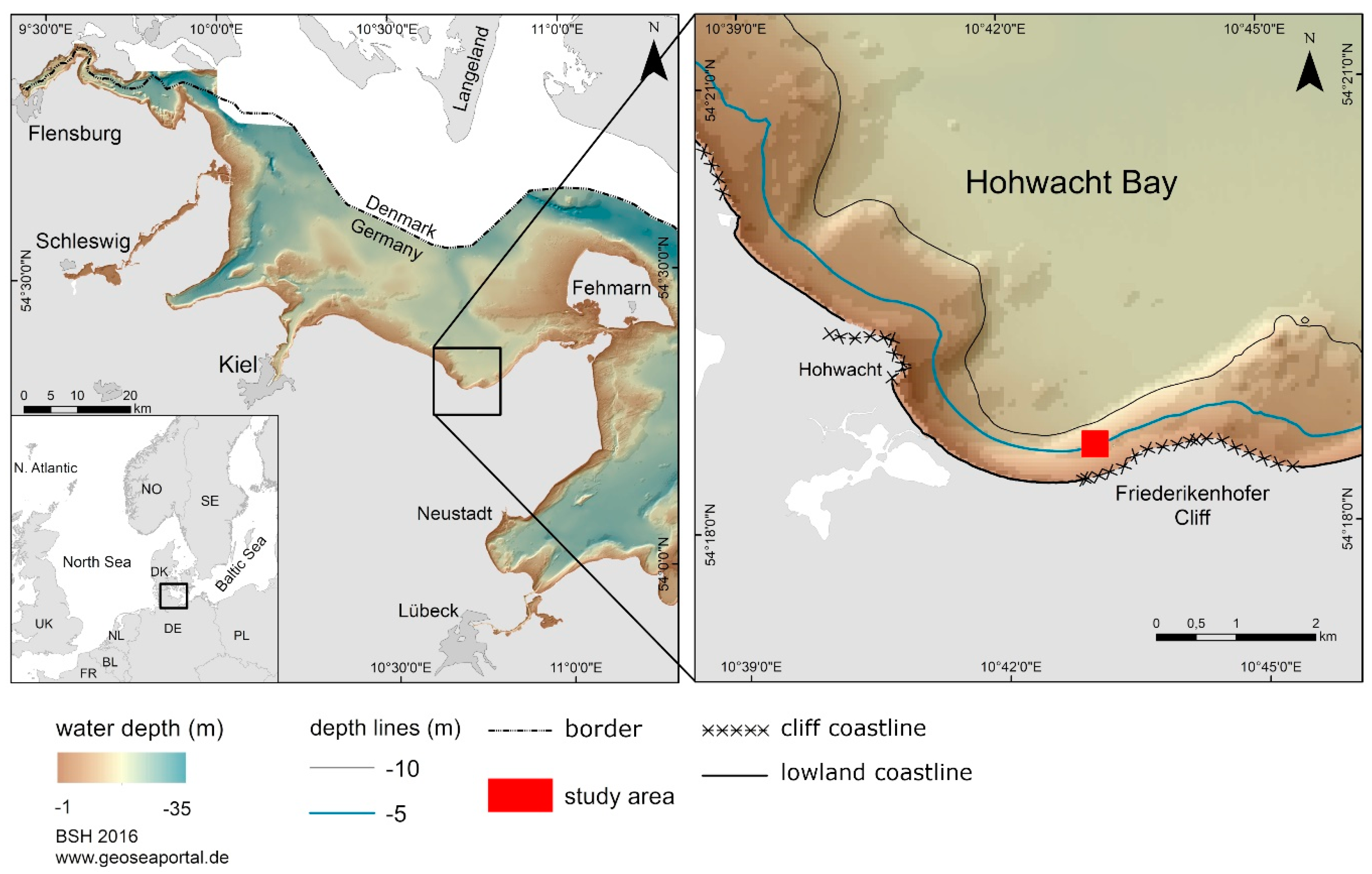
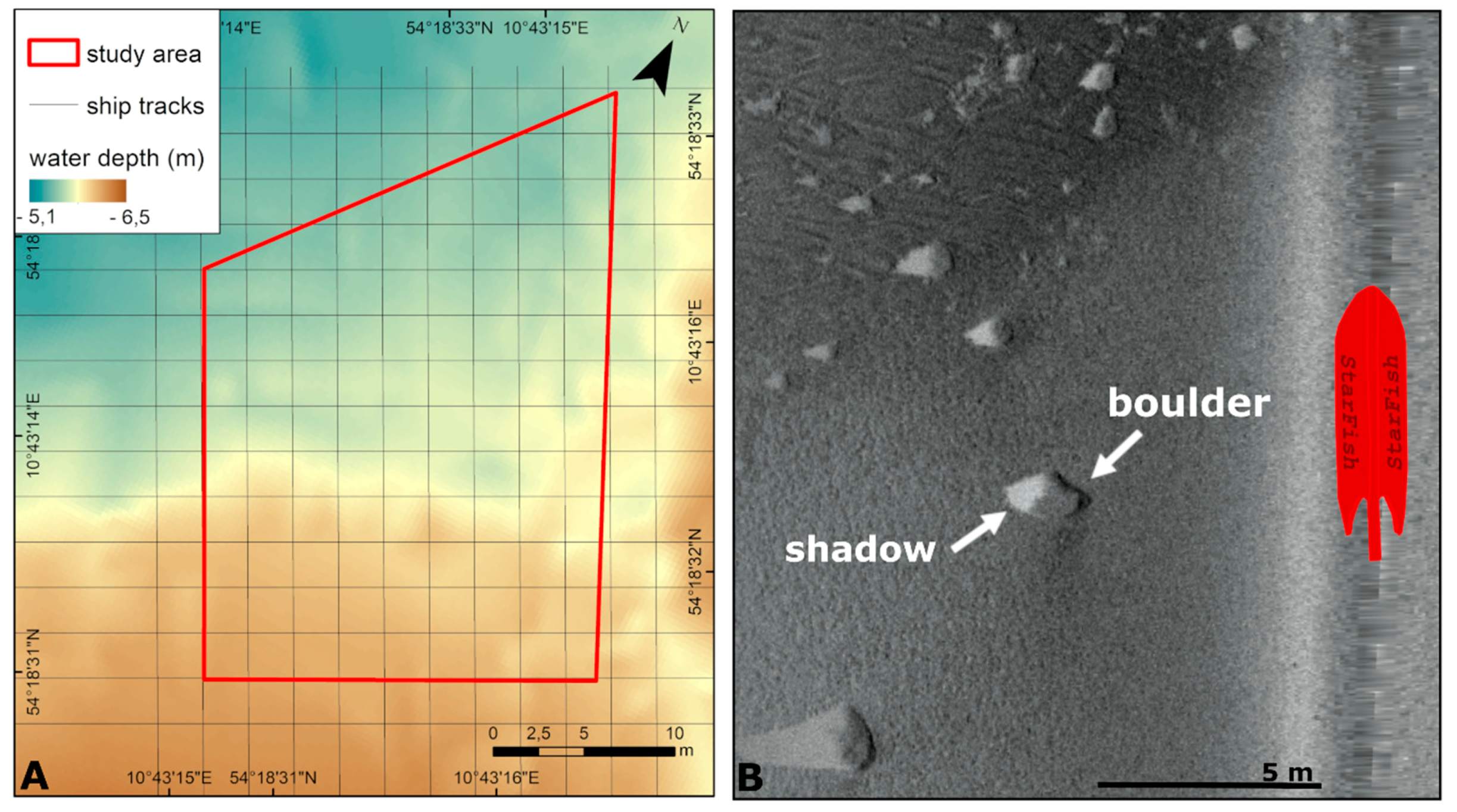

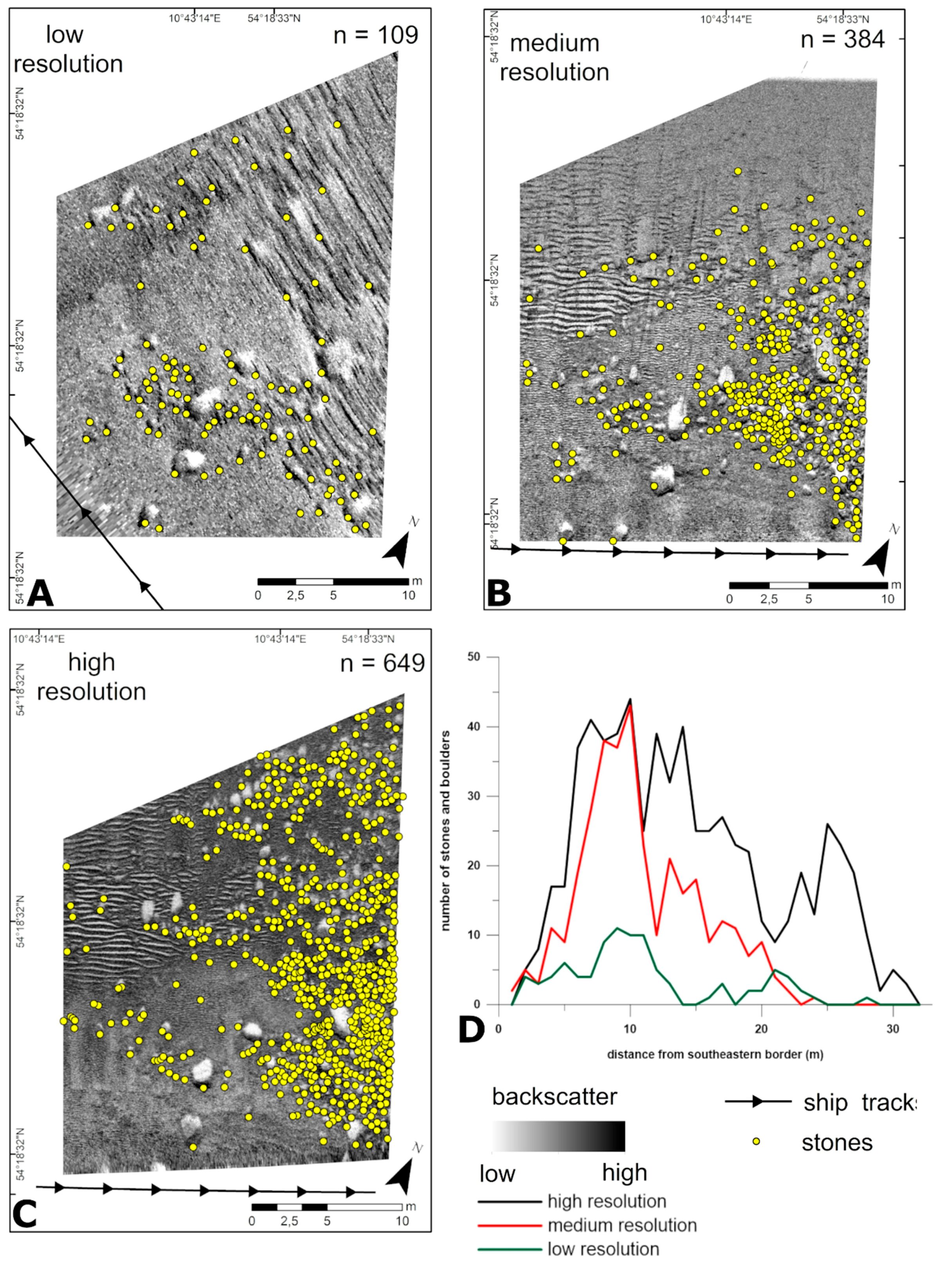
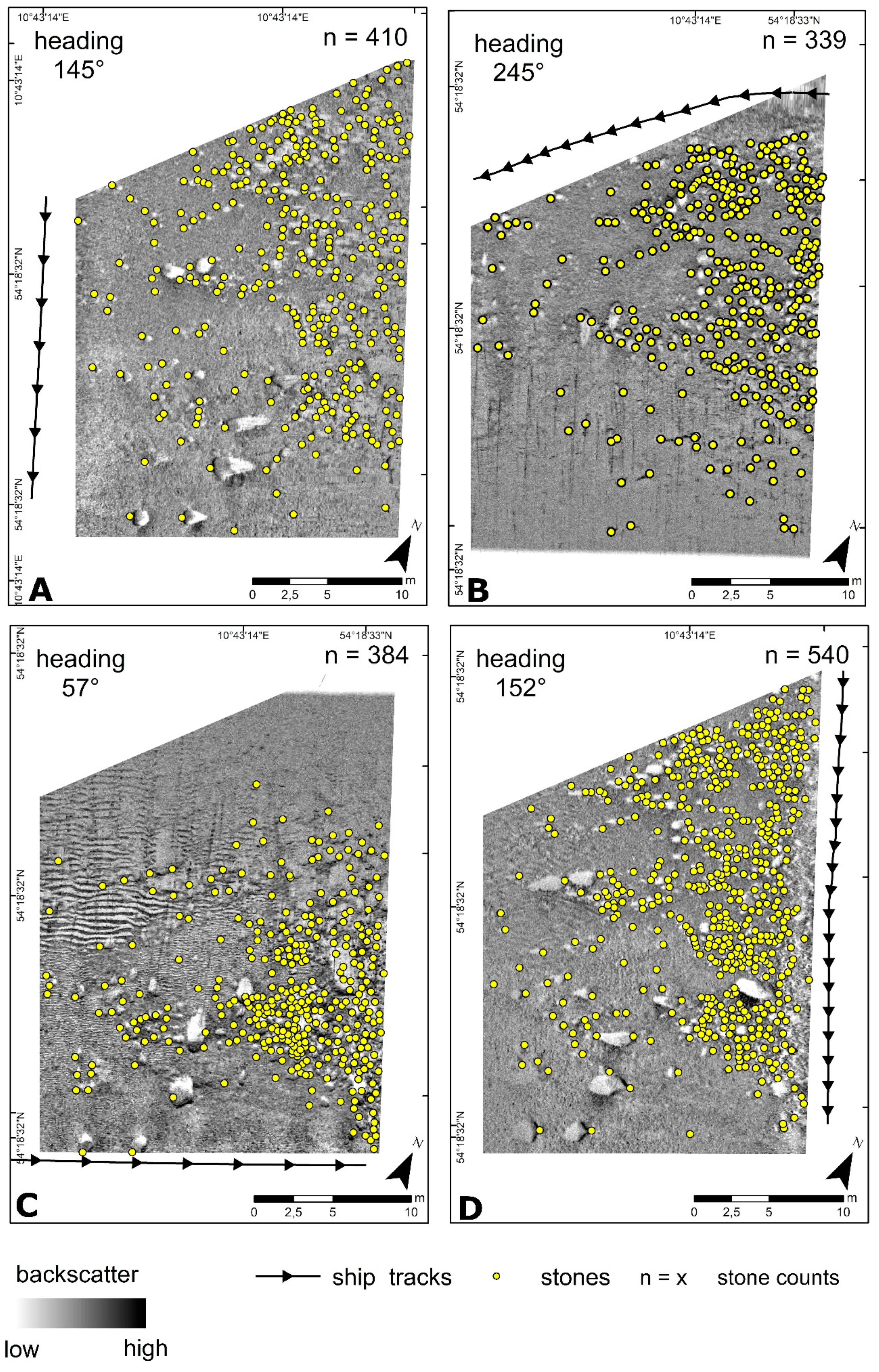

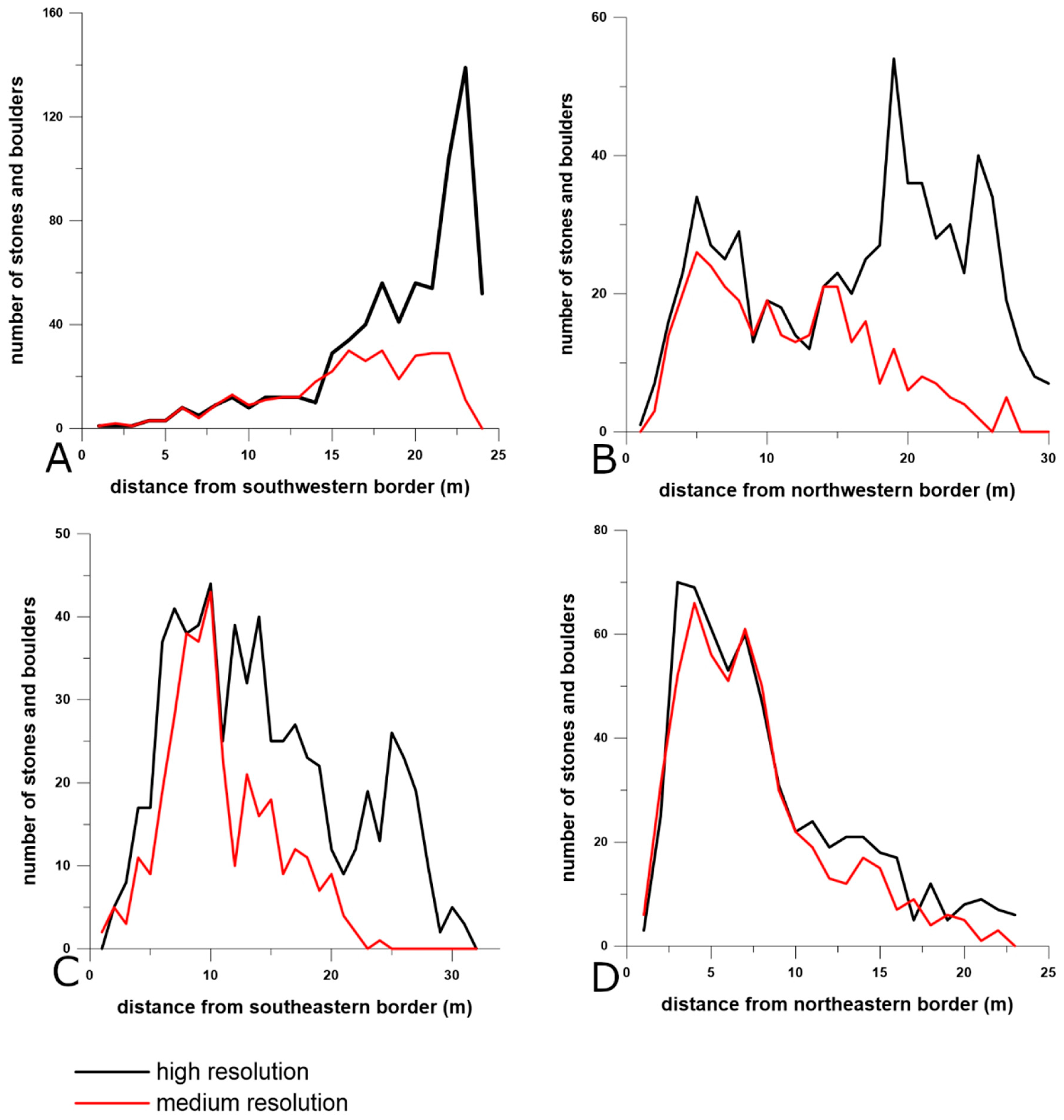
| Parameters/Classes | Low-Resolution | Medium-Resolution | High-Resolution |
|---|---|---|---|
| transmit power | 210 dB re 1μPa @ 1m | 210 dB re 1μPa @ 1m | 210 dB re 1μPa @ 1m |
| frequency | 450 kHz chirp | 1 MHz chirp | 1 MHz chirp |
| pulse length | 400 μs | 100 μs | 100 μs |
| ping rate | 14 Hz | 23 Hz | 43 Hz |
| horizontal beam width | 0.8° | 0.3° | 0.3° |
| vertical beam width | 60° | 60° | 60° |
| selected range | 50 m | 35 m | 10 m |
| average survey speed | 2.3 m/s | 1.0 m/s | 1.0 m/s |
| heading | 294° | 058° | 060° |
| average resolution | 0.2 m/pixel | 0.1 m/pixel | 0.04 m/pixel |
| merged images | - | - | 5 images merged |
| SSS Class | Frequency | Resolution | Minimum Detection Size | Detection Numbers |
|---|---|---|---|---|
| Low resolution | 450 kHz | 0.2 m/pixel | 0.4 m | 109 |
| Medium resolution | 1 MHz | 0.1 m/pixel | 0.2 m | 384 |
| High resolution | 1 MHz | 0.04 m/pixel | 0.08 m | 649 |
| Numbers of Boulders for Each Minimum Detection Size | |||||
|---|---|---|---|---|---|
| 0.4 m | 0.2 m | 0.08 m | Boulder Counts | Calculated Surface Area | |
| low resolution | 109 | - | - | 109 | 41 m2 |
| medium resolution | 109 | 275 | - | 384 | 67 m2 |
| high resolution | 109 | 275 | 265 | 649 | 71 m2 |
© 2019 by the authors. Licensee MDPI, Basel, Switzerland. This article is an open access article distributed under the terms and conditions of the Creative Commons Attribution (CC BY) license (http://creativecommons.org/licenses/by/4.0/).
Share and Cite
von Rönn, G.A.; Schwarzer, K.; Reimers, H.-C.; Winter, C. Limitations of Boulder Detection in Shallow Water Habitats Using High-Resolution Sidescan Sonar Images. Geosciences 2019, 9, 390. https://doi.org/10.3390/geosciences9090390
von Rönn GA, Schwarzer K, Reimers H-C, Winter C. Limitations of Boulder Detection in Shallow Water Habitats Using High-Resolution Sidescan Sonar Images. Geosciences. 2019; 9(9):390. https://doi.org/10.3390/geosciences9090390
Chicago/Turabian Stylevon Rönn, Gitta Ann, Klaus Schwarzer, Hans-Christian Reimers, and Christian Winter. 2019. "Limitations of Boulder Detection in Shallow Water Habitats Using High-Resolution Sidescan Sonar Images" Geosciences 9, no. 9: 390. https://doi.org/10.3390/geosciences9090390





